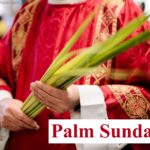
Easter, also called Pascha, celebrates Jesus Christ’s Resurrection from the dead on the third day after his Crucifixion.
It is the oldest and most significant Holy Day in the Church, representing the fulfillment of God’s promises to man. It is the key to salvation.
Raising from the dead was Jesus’ victory over evil, sin, and death and proved that He was the Son of God.
The Easter Holy Day is celebrated on the first Sunday after the first full moon after the spring equinox. It can fall between March 22 and April 25, coinciding with the Jewish Passover.
In the Catholic Church, the season of Easter continues for seven weeks, until Pentecost Sunday.
Easter changes everything:
The Resurrection is an anchor of hope:
Share the good news:
When the Sabbath was over, Mary Magdalene, Mary, the mother of James, and Salome bought spices so that they might go and anoint Him. Very early when the sun had risen, on the first day of the week, they came to the tomb. They were saying to one another, “Who will roll back the stone for us from the entrance to the tomb?” When they looked up, they saw that the stone had been rolled back; it was very large. On entering the tomb they saw a young man sitting on the right side, clothed in a white robe, and they were utterly amazed. He said to them, “Do not be amazed! You seek Jesus of Nazareth, the crucified. He has been raised; He is not here. Behold, the place where they laid Him. But go and tell his disciples and Peter, ‘He is going before you to Galilee; there you will see Him, as He told you.’” Then they went out and fled from the tomb, seized with trembling and bewilderment. They said nothing to anyone, for they were afraid.
Mark 16: 1-8
Truly alive again through the power of God:
The Resurrection is a glorious miracle:
The Church at the site of Jesus’ Crucifixion and Resurrection:
“Why do you seek the living among the dead? He is not here, but has risen.” The first element we encounter in the framework of the Easter events is the empty tomb. In itself it is not a direct proof of Resurrection; the absence of Christ’s body from the tomb could be explained otherwise. Nonetheless the empty tomb was still an essential sign for all. Its discovery by the disciples was the first step toward recognizing the very fact of the Resurrection. This was the case, first with the holy women, and then with Peter. The disciple “whom Jesus loved” affirmed that when he entered the empty tomb and discovered “the linen cloths lying there”, “he saw and believed”. This suggests that he realized from the empty tomb’s condition that the absence of Jesus’ body could not have been of human doing and that Jesus had not simply returned to earthly life as had been the case with Lazarus.
Catechism of the Catholic Church 640
Easter traditions point back to Jesus:
“Victimae paschali laudes / immolent Christiani …” Christians, to the Paschal Victim offer sacrifice and praise. The sheep are ransomed by the Lamb; and Christ, the undefiled, hath sinners to his Father reconciled”. I speak to you, Christians! I speak to you, Catholics, Orthodox, Anglicans and Protestants! I come to you with the marvellous announcement: Christ is risen! The One whom John the Baptist had indicated as the Lamb of God has redeemed his flock: “Agnus redemit oves”. Christ has redeemed the whole human flock, every human being, without exception. Christ, innocent victim on the cross, has reconciled us sinners with the Father. He who was without sin has brought us sinners back to the Father. On this great Feast of Easter we proclaim the reconciliation of humanity with the Father, through the power of Christ who for us became obedient unto death: “Victima paschalis”
Pope John Paul II, Urbi et Orbi Message, March 30, 1997
Easter lasts longer than a day:
The week after Easter is especially significant:
The Mass readings of the Easter season are special:
The Truth, Goodness, and Beauty of the Catholic Church
A new depth of understanding:
Share this page with friends and family to start a conversation about your faith.
Don’t miss a post. Learn more about the Catholic Church and strengthen your Catholic faith.
Find more Fiercely Catholic video issues here.
Subscribe here.


